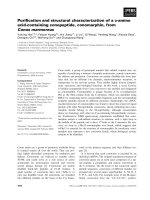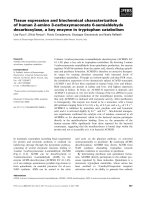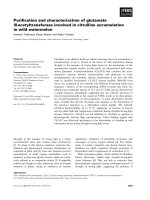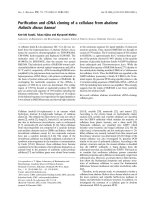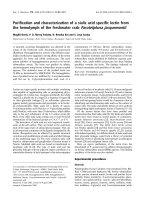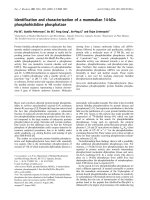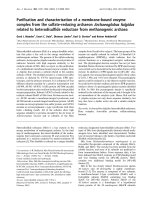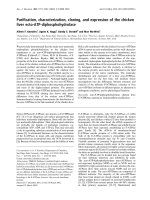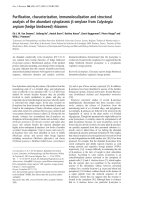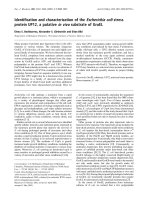Báo cáo Y học: Purification and biochemical characterization of some of the properties of recombinant human kynureninase pptx
Bạn đang xem bản rút gọn của tài liệu. Xem và tải ngay bản đầy đủ của tài liệu tại đây (222.38 KB, 6 trang )
Purification and biochemical characterization of some
of the properties of recombinant human kynureninase
Harold A. Walsh and Nigel P. Botting
School of Chemistry, University of St Andrews, St Andrews, Fife, Scotland, UK
Recombinant human kynureninase (
L
-kynurenine hydrol-
ase, EC 3.7.1.3) was purified to homogeneity (60-fold) from
Spodoptera frugiperda (Sf9) cells infected with baculovirus
containing the kynureninase gene. The purification protocol
comprised ammonium sulfate precipitation and several
chromatographic steps, including DEAE–Sepharose
CL-6B, hydroxyapatite, strong anionic and cationic sepa-
rations. The purity of the enzyme was determined by SDS/
PAGE, and the molecular mass verified by MALDI-TOF
MS. The monomeric molecular mass of 52.4 kDa deter-
mined was > 99.99% of the predicted molecular mass. A
UV absorption spectrum of the holoenzyme resulted in a
peak at 432 nm. The optimum pH was 8.25 and the enzyme
displayed a strong dependence on the ionic strength of the
buffer for optimum activity. This cloned enzyme was highly
specific for 3-hydroxykynurenine (K
m
¼ 3.0 l
M
±0.10)
and was inhibited by
L
-kynurenine (K
i
¼ 20 l
M
),
D
-kynurenine (K
i
¼ 12 l
M
) and a synthetic substrate
analogue
D
,
L
-3,7-dihydroxydesaminokynurenine (K
i
¼
100 n
M
). The activity/concentration profile for kynureninase
from this source was sigmoidal in all instances. There
appeared to be partial inhibition by substrate, and excess
pyridoxal 5¢-phosphate was found to be inhibitory.
Keywords: kynureninase; kynurenine; neuroprotection;
quinolinic acid; tryptophan metabolism.
Rapid progress in the pathophysiology of human diseases
has always been hampered by the availability of human
tissue, aesthetics, and ethical considerations. The principle
aim of this study was to express a clone of human
kynureninase in an appropriate host that would yield
sufficient quantities of protein to permit identification and
biochemical characterization of the enzyme and investiga-
tion into the effects of various synthetic and endogenous
inhibitors. Achieving these objectives could provide an
avenue for pharmacological modulation of the synthesis of
the N-methyl
D
-aspartate receptor agonist and the excito-
toxin, quinolinic acid, in addition to elevating the levels of
the neuroprotective kynurenate [1]. Quinolinic acid has been
implicated as an aetiological factor in a range of neurode-
generative diseases which include epilepsy, Huntington’s
disease, AIDS-related dementia, and septicaemia, where it is
released as part of the inflammatory response to injury [2,3].
Kynureninase is one of the enzymes involved in the
tryptophan metabolic pathway. It is a pyridoxal 5¢-phos-
phate (PLP)-dependent enzyme which catalyses the b,c-
hydrolytic cleavage of the amino acids
L
-kynurenine (1)and
L
-3-hydroxykynurenine (2)togive
L
-alanine (3) and either
anthranilic acid (4) or 3-hydroxyanthranilic acid (5)
(Scheme 1) [4]. This pathway is crucial in the biosynthesis
of nicotinamide nucleotides [5] and also gives rise to other
pathophysiologically important compounds such as picolinic
acid, an enhancer of nitric oxide synthase expression [6].
Kynureninase has been purified and characterized from a
number of different sources, such as bacteria, vertebrates
and fungi, but very little is known about the human form.
The microbial enzyme from some sources has been shown
to be present as two isozymes with differing specificities
toward
L
-kynurenine and 3-hydroxykynurenine [7]. Recom-
binant human enzyme is reported to be a homodimer with a
monomeric molecular mass of 52.4 kDa and shares an
amino-acid sequence homology of about 85% with cyto-
solic rat hepatic kynureninase, which has also been cloned
and expressed [8]. There have been a few attempts to isolate
and purify cloned human kynureninase but with limited
success, although the bacterial enzyme has been cloned [9].
Previous researchers [10] have demonstrated activity in
human embryonic kidney fibroblast (HEK-293)-transfected
cell homogenates with a K
m
of 13.2 l
M
for 3-hydroxyky-
nurenine and 671 l
M
for
L
-kynurenine for the catalytically
active human enzyme.
MATERIALS AND METHODS
Materials
All chemicals (reagent grade) were purchased from Sigma
except for the ion exchangers and the Affi-Blue gel, which
were obtained from Bio-Rad. The nitrocellulose filters used
for concentration and buffer equilibration of active enzyme
fractions were purchased from Millipore (UK).
Protein expression
A cDNA clone encoding human liver kynureninase was a
gift from Dr Andrea Cesura, Hoffman la Roche. The
cDNA was isolated by the method of
1
Alberati-Giani et al.
Correspondence to N. P. Botting, School of Chemistry,
University of St Andrews, St Andrews, Fife KY16 9ST,
Scotland, UK. Fax: + 44 1334 463808, Tel.: + 44 1334 463856,
E-mail:
Abbreviations: PLP, pyridoxal 5¢-phosphate.
Enzyme: kynureninase (
L
-kynurenine hydrolase, EC 3.7.1.3).
7
(Received 27 November 2001, revised 25 February 2002, accepted
25 February 2002)
Eur. J. Biochem. 269, 2069–2074 (2002) Ó FEBS 2002 doi:10.1046/j.1432-1033.2002.02854.x
[10] and cloned into the ÔBac-to-BacÕ Baculovirus Expres-
sion System (Gibco-BRL) which was used to express
kynureninase in Spodoptera frugiperda (Sf9) insect cells
[11]. Sf9 cells were grown at 28 °C in TC-100 suspension
cultures of 10 L containing a minimal amount of fetal calf
serum (1–2%) until 10 mL of growing cells resulted in a
confluent layer when placed in a small Petri dish. Infection
of the Sf9 cells and expression of kynureninase proceeded in
TC-100 in the absence of any fetal calf serum. The infection
was allowed to proceed for 96 ± 12 h depending on the
degree of lysis. Light microscopy was used to monitor the
infection process, and, when isolated nuclei appeared amid a
host of grossly deformed cells, the cells were harvested and
active enzyme extracted. A purification protocol was then
developed (Table 1) to obtain homogeneous enzyme.
Purification protocol
All steps were performed at 4 °C and long-term storage
occurred at )80 °C. The tubes for collecting the various
fractions always contained 20 lL of a 10-m
M
stock PLP
solution in order to increase the stability of kynureninase.
The infected Sf9 cell culture (10 L) was harvested after 96 h
by centrifugation at 5000 g for 7 min. Both the supernatant
and the pellet (whole cells) were retained. Harvested insect
cells were resuspended in cold buffer A consisting of
100 m
M
Tris/HCl buffer (pH 7.5) containing 0.25
M
sucrose, 1 m
M
dithiothreitol, 0.5 m
M
EGTA, 10 l
M
PLP,
100 l
M
phenylmethanesulfonyl fluoride, 2 lgÆmL
)1
apro-
tinin plus 1 lgÆmL
)1
pepstatin and leupeptin, and sonicated
on ice. (All subsequent buffers contained the protease
inhibitors, PLP, dithiothreitol and EGTA at the above
concentrations.) The resultant fraction was then centrifuged
at 12 000 g for 20 min. This procedure was repeated up to
four times with retention of the supernatant. Both supern-
atants were shown to contain all the activity. The superna-
tant was brought to 20% (NH
4
)
2
SO
4
saturation centrifuged
at 10 000 g for 15 min and the pellet discarded. Then the
(NH
4
)
2
SO
4
was increased to 80% to precipitate kynuren-
inase and centrifugation carried out as above. This pellet
was redissolved in 3 mL buffer A, equilibrated with 50 mL
20 m
M
Tris/HCl at pH 8.6 and applied to a DEAE Blue
Sepharose CL-6B affinity column (1.5 · 30 cm) that had
been equilibrated with 10 m
M
Tris/HCl buffer at pH 8.6, at
a flow rate of 1.5 mLÆmin
)1
. The enzyme was eluted in the
unbound fraction devoid of any PLP. Concentration and
equilibration of fractions containing active kynureninase
during this step and elsewhere were performed in an
Amicon ultrafiltration unit incorporating a nitrocellulose
membrane of exclusion limit 50 kDa. This system always
retained the recombinant enzyme. Fractions containing
active enzyme were pooled, equilibrated in 10 m
M
potas-
sium phosphate buffer (pH 7.2), concentrated to 3.0 mL,
and applied to a hydroxyapatite (Ultrogel) column
(3.0 · 25 cm) equilibrated with 10 m
M
potassium phos-
phate buffer at pH 7.2. The column with bound kynuren-
inase was washed with 3 vol. equilibration buffer and then
eluted with a stepwise gradient of sodium phosphate (10–
500 m
M
) buffer at a flow rate of 1 mLÆmin
)1
. Kynureninase
was eluted at 160 m
M
.
Active fractions were again pooled, equilibrated in
20 m
M
Tricine/NaOH, pH 8.8, concentrated to 4.0 mL
and applied to a strong anion-exchange (Macro-Prep strong
S support) column (1.5 · 30 cm) previously equilibrated
with 20 m
M
Tricine/NaOH at pH 8.8 buffer at a flow rate
of 2 mLÆmin
)1
. Bound enzyme was washed with 3 column
vol. equilibration buffer followed by stepwise elution with
NaCl (10–500 m
M
) in column equilibration buffer at a flow
rate of 3.0 mLÆmin
)1
.Theenzymewaselutedat60m
M
NaCl. A Macro-Prep strong Q support column
(1.5 · 30 cm) was equilibrated with 20 m
ML
-His/HCl
buffer at pH 6.0, and the pooled active fractions from the
anion-exchange step were equilibrated (20 m
ML
-His/HCl,
pH 6.0) and concentrated (4.0 mL) as previously. The
concentrated fraction was applied to the column at a flow
rate of 2.0 mLÆmin
)1
, and bound kynureninase was washed
with 3 column vol. equilibration buffer and eluted stepwise
with KCl (0–400 m
M
)in20m
ML
-His/HCl buffer, pH 6.0,
at a flow rate of 3.0 mLÆmin
)1
. Kynureninase was eluted at
60 m
M
KCl. Samples containing kynureninase were
pooled, concentrated (4.0 mL), and equilibrated in buffer
(20 m
M
imidazole/HCl, pH 6.8) as described previously and
applied to the strong anion-exchange column (1.5 · 30 cm)
used earlier at a flow rate of 2.0 mLÆmin
)1
. This column had
been equilibrated with 20 m
M
imidazole/HCl buffer,
pH 6.8. The enzyme was eluted in the unbound fraction
and was pooled, concentrated, and equilibrated in assay
buffer (10 m
M
Tris/HCl, pH 7.9), divided into aliquots, and
stored at )80 °C until further use. The various purification
steps were followed by SDS/PAGE (12% gels) [12]; where a
Table 1. Fractional purification of recombinant human kynureninase from the supernatant of virus-infected insect (Sf9) cells. Specific details are
outlined in the text. All activity assays were performed with 3-hydroxykynurenine as substrate and at saturating PLP.
Step
Total
protein
(mg)
Total
activity
(nmolÆmin
)1
)
Specific
activity
(nmolÆmin
)1
Æmg
)1
)
Fold
purification
%
Yield
80% (NH
4
)
2
SO
4
536 1460 2.7 1.00 100
Affi-Blue CL-6B 242 2183 9.0 3.30 150
Hydroxyapatite 96 3505 36.4 13.3 240
Strong anion @pH 8.9 29 3108 108 39.5 213
Strong cation @pH 6.0 16 2267 139 50.9 150
Strong anion @pH 6.0 8.0 1311 164 60.0 90
Scheme 1.
2070 H. A. Walsh and N. P. Botting (Eur. J. Biochem. 269) Ó FEBS 2002
tryptic mass fingerprint obtained by matrix-assisted laser
desorption ionization time-of-flight (MALDI-TOF) MS of
a band of the expected molecular mass confirmed its identity
as kynureninase. The protein concentrations were deter-
mined with the Bradford assay [13]. Recombinant human
kynureninase from the final anion-exchange step was
assayed for purity using both SDS/PAGE and MALDI-
TOF MS of the whole protein. Both purified and crude
samples of recombinant kynureninase can be stored in the
absence or presence of PLP for extended periods of time
(> 12 months) at )80 °C without any loss of activity. At
4 °C the enzyme is stable for up to 2 weeks in the presence
of PLP, and this is how crude enzyme solution was stored
between successive steps.
Activity assays
Kynureninase activity of the enzyme was monitored spec-
trofluorimetrically at 37 °C, with excitation of the product
3-hydroxyanthranilate at 330 nm and emission at 410 nm
and 310 nm and 417 nm respectively for anthranilate, by
the method of Shetty & Gaertner [7]. A Perkin–Elmer
luminescence spectrometer (model LS50B) connected to a
Grant circulating water bath was used for this purpose. The
final reaction volume was 3.0 mL consisting of 25 nmol
PLP (saturating), 10 m
M
potassium phosphate buffer at
pH 7.9, substrate 3-hydroxykynurenine, and an appropriate
volume of enzyme. Enzyme was always added last for all
reactions including the inhibition studies. The amount of
product formed was determined with reference to a
standard curve of fluorescence intensity against 3-hydroxy-
anthranilate concentration. The kinetic assays were per-
formed using both crude and pure (> 95%) forms of the
enzyme. Reproducibility of the experimental findings was
confirmed with enzyme from different batches and varying
degrees of purity in addition to replicates from within the
same batch, and kinetic analyses showed no significant
difference between the various extracts. A progress curve
was constructed to confirm the linear relationship between
product formation, protein concentration, and time. Lin-
earity of the enzymatic reaction was determined over 5 min.
To achieve temperature equilibration (37 °C), the assay
mixture was incubated for at least 5 min before initiation of
the reaction. Graphs were plotted using the
CRICKETGRAPH
and GraphPad
PRISM
3 software packages, and the kinetic
parameters K
m
and V
max
were obtained using non-linear
regression. Lineweaver–Burk and Dixon [14] plots were
used to characterize the type of inhibition. Hill analysis was
also carried out to confirm the co-operativity.
RESULTS
Using the purification protocol described above, human
recombinant kynureninase was purified > 60-fold from the
supernatant fraction to yield active enzyme with a final
specific activity of 164 nmolÆmin
)1
Æ(mg protein)
)1
.Thefull
results of the purification are given in Table 1.
It is not known why there is an initial increase in the
activity during the purification (Table 1) given that the
purification was performed at saturating PLP concentra-
tions, however, there was no change in the electrophoretic
mobility of the SDS/mercaptoethanol-treated enzyme from
these crude extracts. It is possible that an inhibitor molecule
has been removed during the purification procedure. Disc-
gel electrophoresis in the absence of reducing agents SDS
and mercaptoethanol to determine the native dimeric
molecular mass resulted in the appearance of two bands
at 52.5 and 95 kDa (gel image not shown), and this shows
that the native protein exists mainly in the dimeric form.
There was, however, a fair amount of tailing between the
two bands which was probably due to the continuous
association and disassociation of the respective subunits.
Owing to the asynchronized viral infection cycle, lysis of a
proportion of the transformed insect cells occurred, as was
observed microscopically. This resulted in the presence of
exogenous active kynureninase in the tissue culture medium.
Hence an 80% (NH
4
)
2
SO
4
precipitation was performed on
the supernatant obtained from harvesting the whole cells.
This fraction was purified separately, and the overall yield
was significantly lower than the whole cell fraction but
sufficient to warrant purification. The total pooled (super-
natant + whole cells) enzyme activity from 10 L culture
medium was 14 lmolÆmin
)1
with a specific activity of
164 nmolÆmin
)1
Æmg
)1
(see Table 1 for fractional purifica-
tion of the supernatant). The purified enzyme was shown to
be purified to homogeneity (Fig. 1) by SDS/PAGE on a
12% gel with subsequent Coomassie Brilliant Blue staining.
The molecular mass as determined by MALDI-TOF MS
was 52.4 kDa, which is > 99.99% that of the predicted
amino-acid sequence encoded by the cloned 1600 bp. A
tryptic mass fingerprint obtained by MALDI-TOF MS also
confirmed the identity of the protein as kynureninase. The
UV absorption spectrum of the purified dimeric native
protein at a concentration of 1.80 mgÆmL
)1
in 10 m
M
Tris/
HCl buffer at pH 7.9 and 4 °C showed a peak at 432 nm,
which was due to the presence of the PLP cofactor (data not
shown). This scan was identical with that obtained by
Kishore [15] for kynureninase from Pseudomonas marginalis.
2
Kinetic characterization of the recombinant human
kynureninase revealed that the enzyme was specific for
3-hydroxykynurenine with an experimentally observed K
m
of 3.0 ± 0.10 l
M
for the racemic substrate (
D
,
L
-3-hydroxy-
kynurenine) [8,10]. Graphical analysis shows that the
Fig. 1. Analysis of purified recombinant human kynureninase. SDS/
PAGE (12% gel) of the purified supernatant fraction showing kynu-
reninase (30 lg) at 52.4 kDa in the presence of PLP. The gel was run as
described by Laemmli [11]. Standards were Sigma prestained SDS
molecular mass markers (SDS-7B) in sample buffer containing 4%
SDS and 10% 2-mercaptoethanol.
Ó FEBS 2002 Recombinant human kynureninase (Eur. J. Biochem. 269) 2071
enzyme is subjected to substrate regulation (graph not
shown) and responds to both substrate and inhibitors in a
sigmoidal fashion (Fig. 2). In contrast to previous reports,
no substrate activity could be detected with
L
-kynurenine,
using either a fluorimetric or UV spectroscopic assay.
However,
L
-kynurenine was found to be a competitive
inhibitor at low substrate concentrations (K
i
¼ 20 l
M
)
and non-competitive at higher levels of substrate
(K
i
¢ ¼ 55 l
M
) (Fig. 3).
D
-Kynurenine was also found to
inhibit the enzyme (data not shown, K
i
¼ 12 l
M
)asdida
novel synthetic analogue,
D
,
L
-3,7-dihydroxydesaminoky-
nurenine [16] (Scheme 2), with a K
i
of 100 n
M
.Thelatter
two compounds were also found to be mixed inhibitors of
the enzyme (data not shown).
The pH optimum was determined as 8.25 and the activity
of the enzyme was found to be strongly dependent on the
ionic strength of the buffer. All assays, however, were
performed at pH 7.9 because initial experiments with crude
fractions were performed before the establishment of the
pH-dependence curve. There was no significant difference in
terms of reaction velocity between these two pH values. At
pH 7.9, in 10 m
M
Tris/HCl buffer at 37 °C, velocity against
substrate plots in the absence and presence (Fig. 2) of the
inhibitor
D
,
L
-3,7-dihydroxydesaminokynurenine (100 n
M
)
were all distinctly sigmoidal, as was the percentage inhibition
graph obtained with
L
-kynurenine (Fig. 4). A reciprocal plot
of the data acquired for the
D
,
L
-3,7-dihydroxydesaminoky-
nurenine-inhibited enzyme clearly reveals a highly
co-operative enzyme throughout the whole substrate range,
with negative co-operativity at low concentrations, which
becomes positive as the substrate levels are increased (data
not shown). Similar results were obtained by Hill analysis.
DISCUSSION
The results describe the first purification of human recom-
binant kynureninase to homogeneity. The protein was fully
Fig. 2. Kynureninase activity as a function of 3-hydroxykynurenine ([s])
in the absence (,) and presence [160 n
M
(h) and 5 l
M
(n)3,7-
dihydroxydesaminokynurenine. Runin10l
M
Tris/HCl buffer
(pH 7.9). Data are mean values of three replicate experiments, and the
assay was performed as described in the text.
Fig. 4. Inhibition of kynureninase activity by
L
-kynurenine as a function
of 3-hydroxykynurenine concentration. Data obtained at 10 l
M
Tris/
HCl at pH 7.9, 37 °Cand15l
M
substrate concentration (d). The
depicted kynureninase inhibition is expressed as the percentage of the
inhibition with reference to the activity observed in the absence of
inhibitor.
Scheme 2.
Fig. 3. Mixed inhibition of recombinant human kynureninase by
L
-kynurenine. Competitive inhibition (K
i
¼ 20 l
M
) observed at low
concentrations of substrate which becomes mixed (K
i
¢ ¼ 55 l
M
)at
higher levels of substrate in 10 m
M
Tris/HCl buffer at pH 7.9 and
37 °C, K
m
¼ 3.0 l
M
, specific activity of 164 nmolÆmin
)1
Æ(mg pro-
tein)
)1
and n ¼ 3. Concentrations of
L
-kynurenine in l
M
were 0 (j),
16 (n), 32 (.), 64 (e), 128 (d) and 256 (h).
2072 H. A. Walsh and N. P. Botting (Eur. J. Biochem. 269) Ó FEBS 2002
characterized by electrophoresis (Fig. 1)
3
,MALDI-TOFMS
and UV absorption spectroscopy, and the data are consis-
tent with previous reports [10,11] on the protein. The kinetic
characterization revealed that the human recombinant
kynureninase is specific for 3-hydroxykynurenine, with a
K
m
of 3.0 ± 0.1 l
M
.ThisK
m
value is much lower than
previously reported in this [11] and other laboratories [6] for
the recombinant enzyme, and this is probably because our
findings are for an enzyme displaying sigmoidal kinetics and
thus the calculated ÔK
m
Õ is not the same as the Michaelis
constant K
m
but rather a sigmoidal constant K
s
which
incorporates an interaction factor(s) and hence is not the
substrate concentration at 50% V
max
. The data are,
however, consistent with values obtained for constitutive
enzymes isolated from other species such as Saccharomyces
cerevisiae (K
m
¼ 3.0 l
M
) [17] and the fungus
4
Penicillium
roqueforti (K
m
¼ 4.0 l
M
) [7]. Soda & Tanizawa [18]
reported a K
m
value of 1.67 l
M
for rat hepatic kynurenin-
ase. It was also not possible to show any activity towards
L
-kynurenine, and, at the previously reported K
m
values of
400 l
M
or more, there was significant inhibition of the
enzyme. At a concentration of 250 l
ML
-kynurenine in the
presence of 625 n
MD
,
L
-3-hydroxykynurenine, there was
nearly 80% inhibition (Fig. 4). This is a major difference of
human kynureninase from other mammalian enzymes, such
as rat hepatic kynureninase, and may imply that previous
reports of weak activity with
L
-kynurenine in crude cell
homogenates may be the result of additional adventitious
enzyme activity. Certainly the preference for 3-hydroxyky-
nurenine must be taken into account in inhibitor design. Rat
hepatic kynureninase, on the other hand, showed activity
towards
L
-kynurenine, with a K
m
of 500 l
M
for the partially
purified (> 80%) enzyme. Differential substrate specificity
for kynureninase from brain and liver in mice has been
demonstrated by Chiarugi et al.[19]in vivo, and this raises
the possibility of the existence of two isoforms of the enzyme
as discussed by Toma et al.[8].
The pH optimum of 8.25 is consistent with previously
reported experimentally determined [6] values, and the
optimum activity of the enzyme using this potassium
phosphate buffer system showed a strong dependence on
ionic strength. Molarity increases above 10–20 m
M
result in
a significant fall in activity, which progressively worsens as
the ionic strength is increased.
On the basis of the sigmoidal velocity plots obtained in
the absence and presence of
D
,
L
-3,7-dihydroxydesaminoky-
nurenine (Fig. 2), the enzyme appears to be subjected to
co-operative modulation by the substrate 3-hydroxykynur-
enine. The mixed inhibition depicted by the Lineweaver–
Burk plot in Fig. 3 corroborates this with its reduced V
max
and increased K
m
. The shape of the plot is consistent with
binding of the inhibitor to both the free enzyme (E) and the
enzyme–substrate complex (ES) [15] and hence it can be
inferred that an additional ligand-binding site must be
present on the human enzyme.
When the lines intersect above the x-axis then K
i
< K
i
¢,
and when the lines intersect below the x-axis then K
i
> K
0
i
(in both instances the lines have to intersect to the left of the
y-axis). The data obtained for
L
-kynurenine gave
K
i
¼ 20 l
M
and K
i
¢ ¼ 55 l
M
, while the
D
-isomer (data
not shown) showed very similar behavior.
CONCLUSIONS
The work described shows that appreciable quantities of
active recombinant human kynureninase can be obtained
using a baculovirus/insect cell system followed by a
straightforward purification protocol. This provides a
relatively simple and economical method of producing
active enzyme for use in mechanistic and structural studies.
Characterization of recombinant human kynureninase
shows that it is similar to the rat liver enzyme [4] in terms of
molecular mass, pH optimum, K
m
and sensitivity to
analogue inhibitors, but it also has some important
differences. The human enzyme seems to be completely
specific for 3-hydroxykynurenine with no significant activity
with kynurenine, as reported previously. This may be
important in inhibitor design. Also the enzyme appears to
be subjected to substrate modulation, exhibiting sigmoidal
kinetics. This behaviour could be important in regulation of
enzyme activity in vivo and consequent channeling of
substrate 3-hydroxykynurenine down the tryptophan–
kynurenine metabolic pathway.
The purification of recombinant human kynureninase
to homogeneity has allowed crystallization trials to
commence in our laboratory for elucidation of the
X-ray crystal structure of the protein. The information
obtained should provide invaluable knowledge on the
active site and also pave the way for co-crystallization of
enzyme–substrate and/or enzyme–inhibitor complexes.
These should allow further mechanistic investigation of
the catalytic reaction and hence facilitate subsequent
design and synthesis of effective inhibitors in an attempt
to combat the deleterious effects of the many serious
neurodegenerative disorders.
ACKNOWLEDGEMENTS
A fellowship to H. A. W. from the Wellcome Trust provided the funds
for this study. Dr C. H. Botting is acknowledged for helpful
discussions, performing the MALDI-TOF MS, and valuable compu-
ting assistance.
REFERENCES
1. Baran, H., Cairns, N. & Lubec, B. (1996) Increased kynurenic acid
levels and decreased brain kynurenine aminotransferase I in
patients with Downs syndrome. Life Sci. 58, 1891–1895.
2. Botting, N.P. (1993) Chemistry and neurochemistry of the
kynurenine pathway of tryptophan metabolism. Chem. Soc. Rev.
45, 309–315.
3. Stone, T.W. (2000) Development and therapeutic potential of
kynurenic acid and kynurenine derivatives for neuroprotection.
Tresnds Pharmacol. Sci. Rev. 21, 149–154.
4. Takeuchi, F., Otsuka, H. & Shibata, Y. (1980) Purification and
properties of kynureninase from rat liver. J. Biochem. (Tokyo) 88,
987–994.
Scheme 3.
Ó FEBS 2002 Recombinant human kynureninase (Eur. J. Biochem. 269) 2073
5. Nishizuka, Y. & Hayaishi, O. (1963) Studies on the biosynthesis of
nicotinamide adenine dinucleotide. J. Biochem. (Tokyo) 238,
3368–3377.
6. Mellilo, G., Musso, T., Sica, A., Taylor, L., Cox, G.W. & Varesio,
L. (1995) A hypoxia-responsive element mediates a novel pathway
of activation of the inducible nitric oxide synthase promoter.
J. Exp. Med. 182, 1683–1693.
7. Shetty, A.S. & Gaertner, F.H. (1973) Distinct kynureninase and
hydroxykynureninase activities in microorganisms: occurrence
and properties of a single physiologically discrete enzyme in yeast.
J. Bacteriol. 113, 1127–1133.
8. Toma, S., Nakamura, M., Tone, S., Okuno, E., Kido, R., Breton,
J., Avanzi, N., Cozzi, L., Speciale, C., Mostardini, M., Gatti, S. &
Benatti, L. (1997) Cloning and recombinant expression of rat and
human kynureninase. FEBS Lett. 408, 5–10.
9. Koushik, S.V., Sundararaju, B. & Phillips, R.S. (1997) Cloning,
sequence and expression of kynureninase from Pseudomonas
fluorescens. Arch. Biochem. Biophys. 344, 301–308.
10. Alberati-Gianni, D., Buchli, R., Malherbe, P., Broger, C., Lang,
G., Kohler, C., Lahm, H. & Cesura, A.M. (1996) Isolation and
expression of a cDNA clone encoding human kynureninase. Eur.
J. Biochem. 239, 460–468.
11. Fitzgerald, D.F., Muirhead, K.M. & Botting, N.P. (2001) A
Comparative study on the inhibition of human and bacterial
kynureninase by novel bicyclic kynurenine analogues. Bioorg.
Med. Chem. 9, 983–989.
12. Laemmli, U.K. (1970) Cleavage of structural proteins during the
assembly of the head of bacteriophage T4. Nature (London) 227,
680–685.
13. Bradford, M.M. (1976) A rapid and sensitive method for the
quantitation of microgram quantities of protein utilizing the
principle of protein-dye binding. Anal. Biochem. 72, 248–254.
14. Dixon, M. & Webb, E.C. (1964) The Enzymes, 2nd edn, pp. 116–
145. Academic Press, New York.
15. Kishore, G.M. (1984) Mechanism-based inactivation of bacterial
kynureninase by b-substituted amino acids. J. Biol. Chem. 259,
259–264.
16. Walsh, H.A., Leslie, P.L., O’Shea, K. & Botting, N.P. (2002)
2-Amino-4-[3¢-hydroxyphenyl]-4-hydroxybutanoic acid; a potent
inhibitor of rat and recombinant human kynureninase. Biorg.
Med. Chem. Lett. 12, 361–363.
5
17. Schott, H H. & Krause, U. (1979) Purification and charac-
terization of 3-hydroxykynureinase from yeast. Z Physiol. Chem.
360, 481–488.
6
18. Soda, K. & Tanizawa, K. (1979) Kynureninases: enzymological
properties and regulation mechanism. Adv. Enzymol. Relat. Areas
Mol. Biol. 49, 1–40.
19. Chiarugi, A., Carpanedo, R. & Moroni, F. (1996) Kynurenine
disposition in blood and brain of mice: effects of selective
inhibitors of kynurenine hydroxylase and of kynureninase.
J. Neurochem. 67, 692–698.
2074 H. A. Walsh and N. P. Botting (Eur. J. Biochem. 269) Ó FEBS 2002
